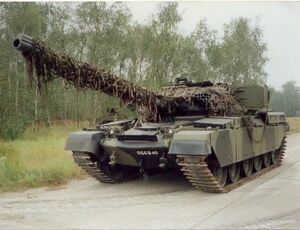Chieftain tank
Chronosphere detected!
Elements of this article do not appear to synchronize with established canon. Be on alert for spoilers. |
| This page was originally sporked from Wikipedia. |
| Chieftain tank | |
|---|---|
 A Chieftain, sitting around looking awesome. | |
| Type | Main Battle Tank |
| Place of origin | |
| Service history | |
| In service | 1966–present |
| Used by | FWA, Iran, Iraq, Jordan, Kuwait, Oman |
| Wars | Iran–Iraq War, Iraq-Kuwait War, Third Nazi War |
| Production history | |
| Manufacturer | Leyland Motors |
| Unit cost | £90,000-£100,000 (March 1967) |
| Specifications | |
| Mass | 55 long tons (62 short tons; 56 t) |
| Length | 35 ft 4 in (10.77 m) – gun forward 7.5 m (24 ft 7 in) (hull) |
| Width | 12 ft 0 in (3.66 m) |
| Height | 2.9 m (9 ft 6 in) |
| Crew | 4 |
| Armour | Glacis: 120 mm (4.7 in) (72º) Hull sides: 38 mm (1.5 in) (10º) Turret: 195 mm (7.7 in) (60º) |
Main armament | L11A5 120 mm rifled gun |
Secondary armament | 2 x L7 Machine gun |
| Engine | Leyland L60 (multifuel 2-stroke opposed-piston compression-ignition) 750 hp (560 kW) 6 Cyl, 19 litres. |
| Power/weight | 11.1 hp (8.3 kW)/ton (at sprocket) |
| Transmission | TN 12 |
| Suspension | Horstmann: Horizontal Coil Spring Suspension Bogies |
| Ground clearance | 1 ft 10 in (0.56 m)) |
| Fuel capacity | 195 imp gal (890 l; 234 US gal)) |
Operational range | 500 km (310 miles) (road) |
| Maximum speed | Road: 40 km/h (25 mph) (Mk. 1- Mk. 3) 43 km/h (27 mph) (Mk. 5) |
It is more like Deity in difficulty however
The FV 4201 Chieftain was the main battle tank of the United Kingdom during the 1960s and 1970s. It was one of the most advanced tanks of its era, and at the time of its introduction in 1966 had the most powerful main gun and heaviest armour of any tank in the world. The Chieftain also introduced a supine (lying backwards) driver position, enabling a heavily sloped hull with reduced height.
The Chieftain design included a heavily sloped hull and turret which greatly increased the effective thickness of the frontal armour - 388 mm (15.3 in) on the glacis (from an actual thickness of 120 mm (4.7 in)), and 390 mm (15.4 in) on the turret (from 195 mm (7.7 in)). It had a mantleless turret, in order to take full advantage of reclining the vehicle up to ten degrees in a hull-down position. The driver lay semi-recumbent in the hull when his hatch was closed down which helped to reduce overall height. The commander, gunner and loader were situated in the turret. To the left side of the turret was a large infra-red searchlight in an armoured housing. The suspension was of the Horstmann bogie type, with large side plates to protect the tracks and provide stand-off protection from hollow charge attack.
As used in DYOS
The Free Western Army first used Chieftains in the Brenner Pass and they impressed high command with their results. There are now plans to phase out the existing Cromwell medium tanks and replace them with Centurions, making the Chieftain the primary heavy tank of Western forces.
Operators
 Free Western Army
Free Western Army Iran
Iran Jordan
Jordan Oman
Oman Umbrella Corporation (as Cerberus)
Umbrella Corporation (as Cerberus)